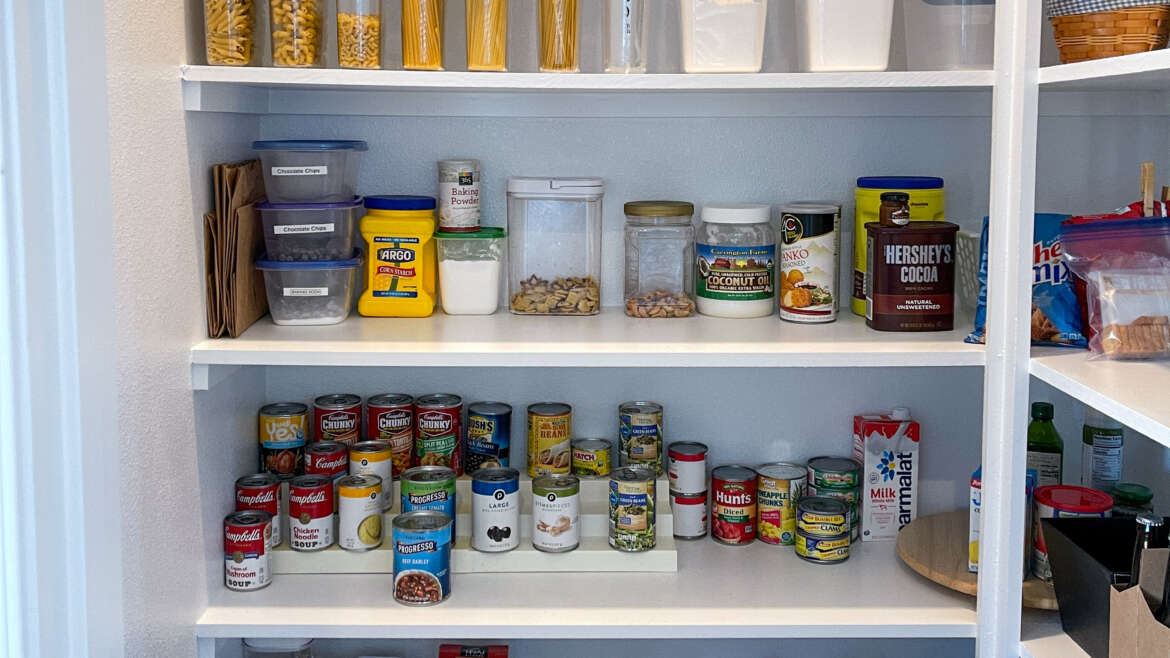Are there items in your pantry that are no longer recognizable as food?
Do the expiration dates on your canned goods shock you?
What surprises lie dormant in the deep dark recesses of the back shelves?
Maybe it’s time to find out. If you haven’t cleaned your pantry recently and gotten rid of expired, stale, partially used, or unpopular purchases, now might be a good time.
Where to start?
Remove everything. Place it on countertops, tables, and work areas. As you do, throw away items that have reached or exceeded their expiration dates. If you’re concerned about the environment, and you know your city’s recycling program accepts them, don’t forget to recycle cardboard, plastic, glass, and certain metals. Cardboard will be the easiest to recycle. Simply empty old cereal boxes, snack boxes, mixes, and other outer containers when disposing of expired contents inside. Then recycle them. Don’t dump jars of thick sauces down your garbage disposal. The goal is not to get a plumber involved in your makeover. Vinegar and other clear liquids should be fine. Some items in jars can be emptied into the trash instead. Even the most avid recycler will end up throwing away some recyclable cans or other containers in the process. Next, get rid of anything you bought with the intention of trying something new, but discovered you didn’t like. It’s good to experiment with new foods, but some just fail the taste test. If you’ve left cracker boxes, chip bags, or sacks of flour open, the contents are probably stale. Throw them out. Dieting? Here’s your opportunity to start fresh by getting rid of high calorie, over-processed, and unhealthy foods. Who needs the temptation? Before you start putting things back, clean the shelves and consider lining them with one of the great products out there. That sticky-backed, hard to position product that dominated the market for a generation has seen a lot of competition in the past few years. So, consider the options before you buy.
Arranging your pantry items
It begins with sorting. I like to group my pantry items into the following general categories, which is similar to the way they’re displayed at your local market:
Canned goods: grouped together by subgroup
Prepared meals – soups, chili, spaghetti and meatballs, other Canned vegetables
Tomato products – sauce, paste, diced, pureed
Legumes – baked beans, navy beans, kidney beans, etc.
Protein Foods:
Meats
Seafood
Peanut butter
Nuts
Fruits:
Dried fruits
Fruit cups
Fruit bars
Dry Goods: each in their separate spots, but near each other
Pasta
Rice
Legumes – dried beans, peas, lentils, etc.
Packaged side dishes
Baking and Cooking:
Packaged mixes – muffins, cakes, cookies, brownies
Flour
Granulated sugar
Powdered sugar
Brown sugar
Other sweeteners
Baking powder / Baking soda
Cocoa Powder
Cooking:
Oils
Vinegar
Spices
Syrups
Bread crumbs
Croutons
Sauce and spice packets
Other flavorings
Breakfast Foods:
Ready to eat cereal
Oatmeal, grits, pancake mixes
Pudding, gelatin, tapioca
Breakfast bars
Beverages:
Water
Juice
Sodas
Powdered drinks
Hot chocolate
Tea
Coffee
Condiments:
Pickles
Olives
Ketchup
Mayonnaise
Mustard
Salad dressing
Jams and jellies
Sauces
Snacks:
Snack bars
Chips
Crackers
Cookies
Candy
Other items that may find a place in your pantry include pet food, paper plates, napkins, plastic cutlery, paper towels, lunch bags, aluminum foil, clear plastic wrap, and storage bags. If you are lucky enough to have a very large pantry you may even store your seldom used electrical appliances, serving pieces, cook books, or picnic supplies.
Keeping it contained
Now that you’ve sorted the contents of your pantry and eliminated the excess, it’s time to consider where you’ll put everything. If you buy in bulk, take into account the amount of space you’ll need when you bring home the next big load, or decide on an alternate location for the overflow. Perhaps a nearby closet or laundry room cupboard will work for you. Consider putting grains, flour, sugar, and other items which are not individually wrapped into clear airtight containers. In addition to immediately seeing what’s inside, food will stay fresher and maintain a longer shelf life. Before purchasing containers measure the depth and height of shelves to be sure they’ll fit. If you have movable shelves, don’t be afraid to rearrange them to meet your Needs To maximize space add door mounted racks. If you have deep shelves and can’t see what’s in the back, purchase expandable tiered plastic shelves which sit on top of your permanent shelves. They’re especially popular for holding spice jars and canned goods.
As you refill your pantry, remember these tips:
Lazy Susans work great in corners allowing you to see and reach what’s there. I also like them for vinegar, oil and other messy liquids. They’re much easier to clean, than your pantry shelf. If you have young children in the house, you can influence smart snacking choices and promote independence by keeping the food they’re allowed to eat on lower shelves, in containers they can easily access. Allocate “prime real estate” to those items you use regularly. These are the areas that are at or near eye level, and easy to reach.
To keep packets and individually wrapped items from slipping, sliding and falling off shelves, use small wicker baskets, clear plastic drawers, or even decorative canisters, boxes or bins to keep them organized and in place. When you’re all done, stand back, look around and take pride in your beautiful and functional pantry!

